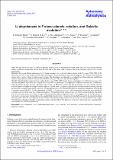Files in this item
Li abundances in F stars : planets, rotation, and Galactic evolution
Item metadata
| dc.contributor.author | Delgado Mena, E. | |
| dc.contributor.author | Bertrán de Lis, S. | |
| dc.contributor.author | Adibekyan, V. Zh. | |
| dc.contributor.author | Sousa, S. G. | |
| dc.contributor.author | Figueira, P. | |
| dc.contributor.author | Mortier, A. | |
| dc.contributor.author | González Hernández, J. I. | |
| dc.contributor.author | Tsantaki, M. | |
| dc.contributor.author | Israelian, G. | |
| dc.contributor.author | Santos, N. C. | |
| dc.date.accessioned | 2015-08-10T16:10:01Z | |
| dc.date.available | 2015-08-10T16:10:01Z | |
| dc.date.issued | 2015-04-01 | |
| dc.identifier | 196538890 | |
| dc.identifier | 4b3df940-e53c-4259-87ed-e7f2d5cb1b07 | |
| dc.identifier | 84926459646 | |
| dc.identifier | 000357274600004 | |
| dc.identifier.citation | Delgado Mena , E , Bertrán de Lis , S , Adibekyan , V Z , Sousa , S G , Figueira , P , Mortier , A , González Hernández , J I , Tsantaki , M , Israelian , G & Santos , N C 2015 , ' Li abundances in F stars : planets, rotation, and Galactic evolution ' , Astronomy & Astrophysics , vol. 576 , A69 . https://doi.org/10.1051/0004-6361/201425433 | en |
| dc.identifier.issn | 0004-6361 | |
| dc.identifier.other | BibCode: 2015A&A...576A..69D | |
| dc.identifier.uri | https://hdl.handle.net/10023/7175 | |
| dc.description | E.D.M., S.G.S. and V.Zh.A. acknowledge support from the Fundação para a Ciência e Tecnologia, FCT (Portugal) in the form of grants SFRH/BPD/76606/2011, SFRH/BPD/47611/2008, and SFRH/BPD/70574/2010, respectively. P.F. acknowledges support by Fundação para a Ciência e a Tecnologia (Portugal) through Investigador FCT contracts of reference IF/01037/2013 and POPH/FSE (EC) by FEDER funding through the program “Programa Operacional de Factores de Competitividade – COMPETE”. J.I.G.H. acknowledges support from the Spanish Ministry of Economy and Competitiveness (MINECO) under the 2011 Severo Ochoa Program MINECO SEV-2011-0187. N.C.S., A.M., and M.T. acknowledge support from the European Research Council/European Community under the FP7 through Starting Grant agreement number 239953, as well as support through programme Ciência 2007 funded by FCT/MCTES (Portugal) and POPH/FSE (EC), and in the form of grant PTDC/CTE-AST/098528/2008. A.M. is supported by the European Union Seventh Framework Programme (FP7/2007-2013) through grant agreement number 313014 (ETAEARTH). | en |
| dc.description.abstract | Aims. We aim, on the one hand, to study the possible differences of Li abundances between planet hosts and stars without detected planets at effective temperatures hotter than the Sun, and on the other hand, to explore the Li dip and the evolution of Li at high metallicities. Methods. We present lithium abundances for 353 main sequence stars with and without planets in the Teff range 5900–7200 K. We observed 265 stars of our sample with HARPS spectrograph during different planets search programs. We observed the remaining targets with a variety of high-resolution spectrographs. The abundances are derived by a standard local thermodynamic equilibrium analysis using spectral synthesis with the code MOOG and a grid of Kurucz ATLAS9 atmospheres. Results. We find that hot jupiter host stars within the Teff range 5900–6300 K show lower Li abundances, by 0.14 dex, than stars without detected planets. This offset has a significance at the level 7σ, pointing to a stronger effect of planet formation on Li abundances when the planets are more massive and migrate close to the star. However, we also find that the average vsini of (a fraction of) stars with hot jupiters is higher on average than for single stars in the same Teff region, suggesting that rotational-induced mixing (and not the presence of planets) might be the cause for a greater depletion of Li. We confirm that the mass-metallicity dependence of the Li dip is extended towards [Fe/H] ~ 0.4 dex (beginning at [Fe/H] ~−0.4 dex for our stars) and that probably reflects the mass-metallicity correlation of stars of the same Teff on the main sequence. We find that for the youngest stars (<1.5 Gyr) around the Li dip, the depletion of Li increases with vsini values, as proposed by rotationally-induced depletion models. This suggests that the Li dip consists of fast rotators at young ages whereas the most Li-depleted old stars show lower rotation rates (probably caused by the spin-down during their long lifes). We have also explored the Li evolution with [Fe/H] taking advantage of the metal-rich stars included in our sample. We find that Li abundance reaches its maximum around solar metallicity, but decreases in the most metal-rich stars, as predicted by some models of Li Galactic production. | |
| dc.format.extent | 24 | |
| dc.format.extent | 580690 | |
| dc.language.iso | eng | |
| dc.relation.ispartof | Astronomy & Astrophysics | en |
| dc.subject | Stars: abundances | en |
| dc.subject | Stars: fundamental parameters | en |
| dc.subject | Stars: rotation | en |
| dc.subject | Stars: evolution | en |
| dc.subject | Planets and satellites: formation | en |
| dc.subject | Planetary systems | en |
| dc.subject | QC Physics | en |
| dc.subject | QB Astronomy | en |
| dc.subject | NDAS | en |
| dc.subject.lcc | QC | en |
| dc.subject.lcc | QB | en |
| dc.title | Li abundances in F stars : planets, rotation, and Galactic evolution | en |
| dc.type | Journal article | en |
| dc.contributor.sponsor | European Commission | en |
| dc.contributor.institution | University of St Andrews. School of Physics and Astronomy | en |
| dc.identifier.doi | https://doi.org/10.1051/0004-6361/201425433 | |
| dc.description.status | Peer reviewed | en |
| dc.identifier.grantnumber | en |
This item appears in the following Collection(s)
Items in the St Andrews Research Repository are protected by copyright, with all rights reserved, unless otherwise indicated.

